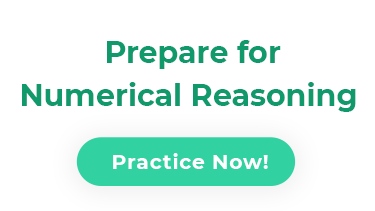Mathematical Reasoning Tests Practice & How to Get Ready for Them? [2025]

What Is Mathematical Reasoning?
Mathematical reasoning is the ability to use quantitative data to identify patterns, solve problems without a pre-existing formula, interpret graphs and find plausible conclusions when presented with numerical evidence. Mathematical reasoning is a high-caliber form of critical thinking and problem-solving that is sought after in a variety of fields including healthcare, finance, and mechanical-based occupations.
What Is a Mathematical Reasoning Test?
Mathematical reasoning tests are administered to evaluate the aforementioned skills. This is achieved with questions that assess the candidate’s aptitude with basic mathematical functions, percentages, ratios, fractions, and statistics among other numerical disciplines. Depending on the field you are interested in, you may come across one of the following tests:
- Basic Skills Test
The basic skills test is slightly different than the others because it covers more bases than just mathematical reasoning. The basic skills test also assess verbal skills and evaluates these two abilities alongside one another. This test will be equal parts math and verbal reasoning. It is commonly used to place candidates for multiple roles rather than evaluating them for one position.
- Basic Numeracy Test
The basic numeracy test appraises the candidate’s mathematical foundation. Questions will consist of the fundamentals such as: algebra, decimals, geometrical concepts, and the four operations. This test is most common for administrative and operational jobs but is utilized to assess applicants seeking employment for jobs that require the use of basic math on a regular basis.
- Numerical Reasoning Test
The numerical reasoning test is the most popular mathematical reasoning assessment to date. This test is more comprehensive than the previously detailed assessments because candidates must interact with ‘real world’ problems. They will be presented with graphs, tables and charts that fit a hypothetical scenario that is prevalent in their field. From there, they must find a solution and choose the correct answer from a list of choices.
- Advanced Numerical Reasoning
The advanced numerical reasoning test follows a similar structure as the numerical reasoning test; however, it is considered much more difficult. The advanced version assesses your unlearned abilities alongside your prior knowledge of the content. This includes formulas that are not explicitly stated, the ability to interpret data and graphs, and strong analytical skills are a must.
- Critical Numerical Reasoning Test
The critical numerical reasoning test is a subcategory of the advanced numerical reasoning tests. The difference is the precision of the critical numerical reasoning tests. This assessment is methodical and is typically administered to job seekers interested in technology or engineering.
- Currency and Unit Conversion Test
The currency and unit conversion test is very simple. The candidate is asked to take a number and convert it to an international currency or unit. For example, what would forty American dollars be in Euros?
- Non-Calculator Test
The non-calculator test is exactly what it sounds like; a math test without a calculator. This test will be comprised of the same principles as any other numerical reasoning test; however, the numbers are smaller and easier to work with. This test serves the purpose of assessing the candidate’s ability to work through problems mentally. To accomplish this, the non-calculator tests must be completed within a smaller amount of time than the other assessments.
How Is the Mathematical Reasoning Test Scored?
The mathematical reasoning test scores are reported to the employer as a raw score and a percentile score. The raw score is the amount of correct answers. A percentile score is how well you fared in comparison to your norm group. Your norm group will be a collection of scores from people in the same field as you at the same level of experience.
While your raw score is important, employers typically emphasize the percentile score because it tells them if you exceed, meet, or fail to meet their benchmark. For example, if you were to achieve a percentile score of eighty, that would tell the company that you did better than 80% of the people that have taken this assessment. The percentile is on a scale of zero to one hundred with fifty being the average.
Most companies will not send you your exact scores, instead, you will receive a notification alerting you if you have passed or not. Some companies will send you a feedback report which details the areas you should work on. A few common subsets are:
- Data interpretation
- Applied Mathematics
- Algebra & Geometry
- Fractions & Ratios
The score that is expected out of you depends on the requirements of the company. It is important to keep in mind that companies will bar numerous candidates from consideration if they don’t meet or exceed their standards.
When Will I Take the Mathematical Reasoning Test?
The mathematical reasoning test is most commonly administered during the interview process. The pre-employment math test is administered after the initial screening as an objective measure of the candidate’s numerical aptitude. If a candidate is successful in the first stage of the recruitment process, they will receive the online assessments via email within one or two weeks. Candidates are asked to complete the assessments within a specified number of days, after which the candidate will be notified of their standing within the week.
How to Prepare for the Mathematical Reasoning Test?
Math is a difficult subject for most. The mathematical reasoning test questions are designed to trip you up and the answer choices can be identical and confusing. Luckily, the content of the mathematical reasoning tests can be studied which is uncommon for aptitude tests.
If you want to prepare for your mathematical reasoning test successfully, review the previously described subsets by working through practice problems. The best study tools are online practice tests. By using these tests, you can prepare for both the material and the time constraint. It’s important to practice with the running clock because many candidates find themselves skipping or guessing at the questions; this method negatively impacts both your raw and percentile score. If you spend some time using the online practice tests, you can find the pace that works best for you.
Another benefit of the online practice tests is their variety. You will be able to prepare for each type of question from percentages to analysis. After you have taken the practice test, if you feel unsure about a certain subset, you can narrow your preparation to make certain that you do well in that section during the test.

